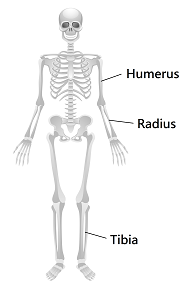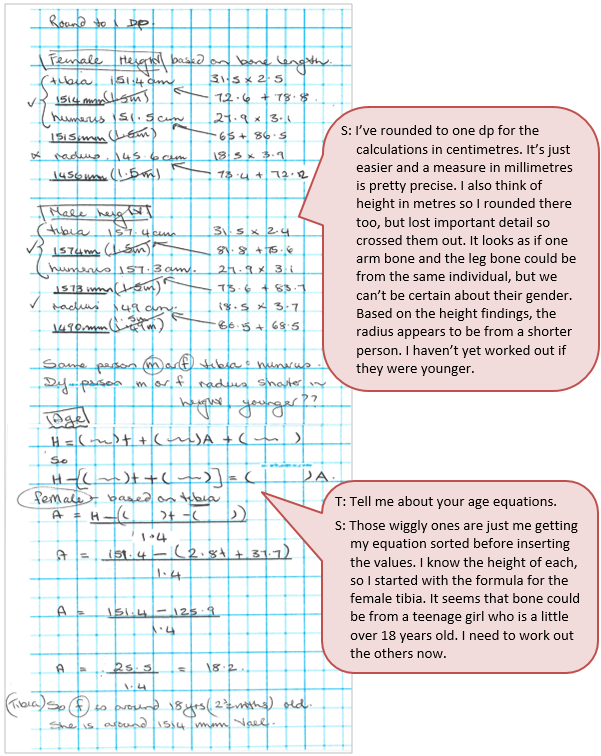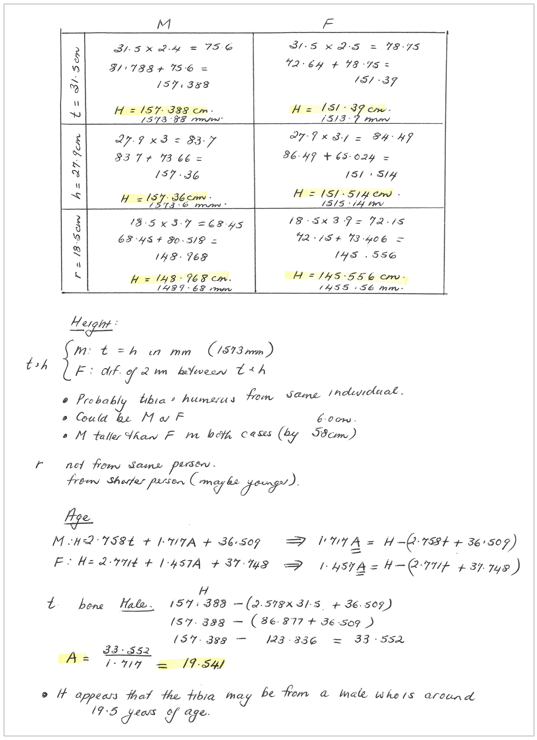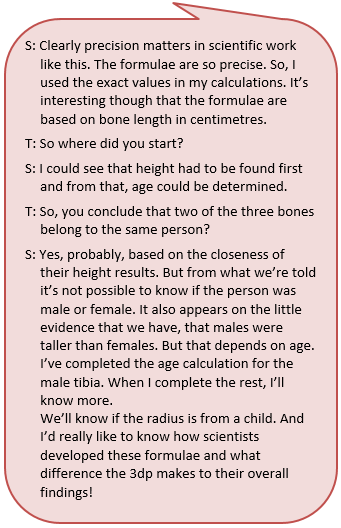The purpose of this activity is to engage students in solving a measurement problem.
. This activity assumes the students have experience in the following areas:
- Working with metric units, particularly for length
- Calculation with decimals
- Proportional reasoning (Working with fractional relationships)
- Using linear algebraic formulae
The problem is sufficiently open ended to allow the students freedom of choice in their approach. It may be scaffolded with guidance that leads to a solution, and/or the students might be given the opportunity to solve the problem independently.
The example responses at the end of the resource give an indication of the kind of response to expect from students who approach the problem in particular ways.

- tibia (t) = 31.5cm
- humerus (h) = 27.9cm
- radius (r) = 18.5cm
He uses these scientifically developed formulae, based on bone length in centimetres, to predict the person's height and age.
Height
| Age Male: H = 2.758t + 1.717A + 36.509 |
What can be determined about the person or persons to whom the bones belonged?
The following prompts illustrate how this activity can be structured around the phases of the Mathematics Investigation Cycle.
Make sense
Introduce the problem. Allow students time to read it and discuss in pairs or small groups.
- Do I understand all the words, or should I ask for help? (Is the meaning of each equation clear? What are the variables?
- Does this look/sound like a problem I have worked on before? (Have you solved equations like this before?)
- Is there an order to solving this problem? (Height is needed to find age)
Plan approach
Discuss ideas about how to solve the problem. Emphasise that, in the planning phase, you want students to say how they would solve the problem, not to actually solve it.
- What are the maths skills I need to work this out? (Substituting values into formulae to find missing values.)
- What could the solution be? What is a sensible estimate? (How tall and old is it reasonable to expect a person to be?)
- What could the solution definitely not be?
- Which strategies should I pursue?
- What tools (digital or physical) could help my investigation?
Take action
Allow students time to work through their strategy and find a solution to the problem.
- Does my answer seem correct? Is it close to my estimation? Is there room for uncertainty? (the predicted heights and ages cannot be exact)
- Have I recorded my ideas in a way that helps me to see patterns?
- Are there any patterns?
- Does my solution make sense? Does it match my estimation?
- Does my solution answer the question?
Convince yourself and others
Allow students time to check their answers and then either have them pair share with other groups or ask for volunteers to share their solution with the class.
- Show and explain how you worked out your solution.
- What connections can I see to other situations, why would this be? (Would the archaeologist’s method work on ‘live’ humans?)
- Which ideas or tools worked well in my investigation?
- What could I try differently next time?
- Is there some mathematics that I would like to be able to do that I can't, at the moment? (Is more practice with linear equations and substitution needed?)
- Which ideas would convince others that my findings answer the investigation question?
Examples of work
Work sample 1
The student finds unknowns that lead to the solution of the problem.
Click on the image to enlarge it. Click again to close.
Work sample 2
The student finds unknowns that lead to the solution of the problem, independently and with appropriate accuracy.


